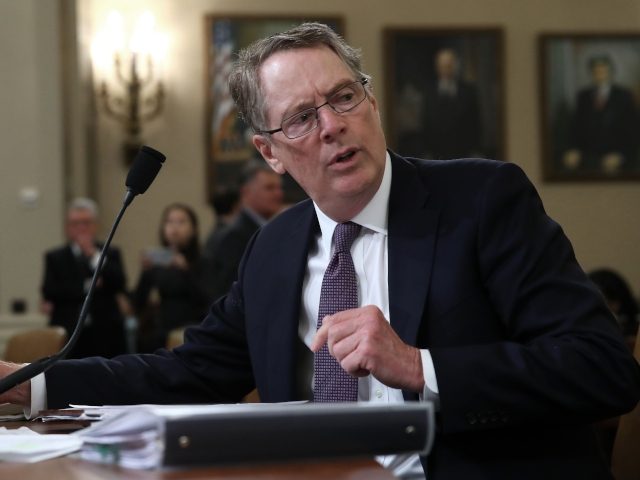U.S. Trade Representative Robert Lightizer filed a notice in the federal register formally announcing that tariffs on about $200 billion of Chinese goods will rise from 10 percent to 15 percent on Friday.
The filing is scheduled to be published on Thursday but is already available on the federal register website.
“In the most recent negotiations, China has chosen to retreat from specific commitments agreed to in earlier rounds. In light of the lack of progress in discussions with China, the President has directed the Trade Representative to increase the rate of additional duty to 25 percent,” Lighthizer said in the filing.
The U.S imposed the 10 percent tariff in September and announced the tariff would rise to 25 percent in January. Earlier last year, the U.S. had imposed a 25 percent tariff on about $50 billion of imports from China.
The tariffs were put on hold when President Donald Trump and China’s Xi Jinping agreed to a trade truce while the two nations negotiated a deal. At first, those talks were given a 90-day deadline before tariffs would rise but that deadline was waived and put on hold indefinitely after U.S. officials told the president that talks were productive.
The situation changed dramatically on Sunday. After a week of reports that the U.S might be willing to accept a deal that did not require the level of structural reforms to the Chinese economy that Trump administration officials had called for, President Donald Trump tweeted an announcement that the tariffs would go up to 25 percent on Friday and the remaining $325 billion of Chinese goods would be subject to tariffs shortly. He accused China of attempting to renegotiate the deal, going back on commitments made earlier.
Behind the scenes, the push for higher tariffs began on Friday night. A diplomatic cable from Beijing arrived in Washington with systematic edits the draft trade agreement that shocked U.S. officials because it appeared to take back so much of what they had thought China had already agreed to.
Reuters reported that in each of the seven chapters of the draft trade deal, China had deleted its commitments to change laws to resolve core U.S. complaints: Theft of U.S. intellectual property and trade secrets; forced technology transfers; competition policy; access to financial services; and currency manipulation. China’s position was that it would adopt policies to meet the demands but not actually change its laws.
The change in China’s stance on tariffs appears to reflect Chinese domestic political pressure. China’s nationalist hawks considered the demand for actual legal changes unacceptable, according to people familiar with the matter. Some have argued that such a public change would make China look weak.
Some in the U.S. and China speculated on Sunday and Monday that Trump’s Sunday tweets might be just an empty threat intended to give U.S. negotiators additional leverage in the talks. That raised the possibility that the tariffs might not actually be raised. Financial markets in the U.S. seemed remarkably calm on Monday.
That changed Monday evening after Lighthizer and Treasury Secretary Steven Mnuchin spoke to reporters. Both men explained that China’s backtracking had resulted in the need to push tariffs higher. Lighthizer said he would be filing the paperwork as soon as possible and that tariffs would go up at midnight Friday.
Stocks sold off sharply on Tuesday in reaction, although the market closed above its lows for the day. By Wednesday, however, the three major index were set to close higher.
Trade talks are expected to resume this week. After a brief hesitation following the announcement of the higher tariffs, China confirmed it would still send officials to Washington to meet with their American counterparts.

COMMENTS
Please let us know if you're having issues with commenting.